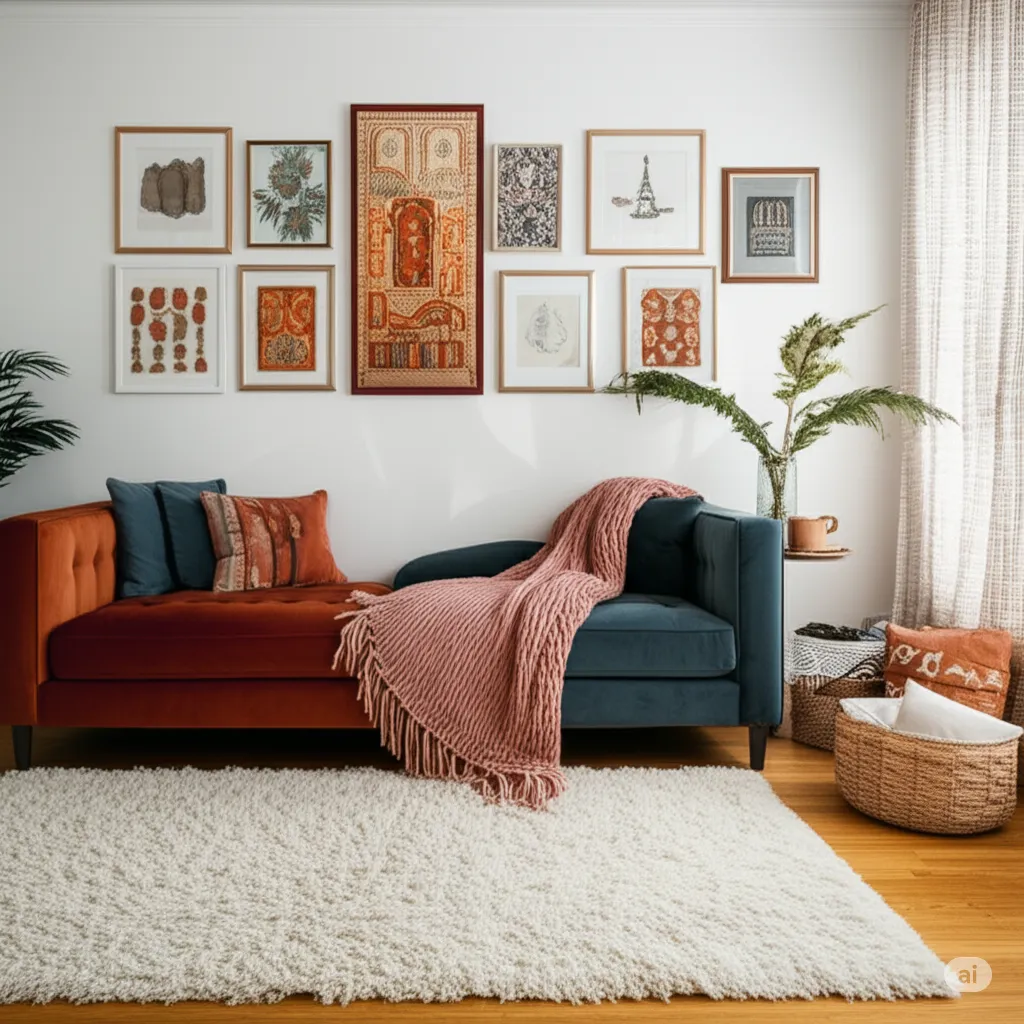Texture is one of the most overlooked yet powerful elements in interior design. While color, furniture, and layout are essential, it’s texture that brings depth, warmth, and visual richness to a space. Whether you’re going for a cozy, rustic feel or a sleek, modern aesthetic, incorporating texture is key to creating a balanced and inviting room. In this guide, you’ll learn how to use texture to enhance your home and make every space feel more dynamic and welcoming.
What Is Texture in Interior Design?
Texture refers to the surface quality of materials—how they look and feel. It can be visual (how something appears) or tactile (how it feels when touched). A well-designed room combines various textures to create contrast, interest, and a sense of comfort.
Examples of Texture:
- Soft: velvet, faux fur, plush rugs.
- Rough: raw wood, brick, woven baskets.
- Smooth: glass, metal, marble.
- Patterned: embossed wallpaper, textiles with raised designs.
When you layer these elements thoughtfully, your home becomes more visually engaging and comfortable to be in.
Start with a Neutral Base
Neutral tones allow textures to shine. When your color palette is more subdued, the contrast between rough and smooth, soft and hard, becomes more noticeable.
Why Neutrals Work:
- Allow you to experiment with bold textures without overwhelming the space.
- Help create a calm, cohesive backdrop for layering.
- Complement almost any material—wood, fabric, stone, or metal.
Begin with neutral walls, flooring, and large furniture pieces, and build texture from there.
Layer Different Textiles
Textiles are the easiest and most affordable way to add texture. They soften the space and make it feel lived-in and cozy.
Key Pieces to Include:
- Throw blankets with knit or fringe finishes.
- Cushions in a variety of fabrics: linen, velvet, wool.
- Curtains in heavy or layered materials.
- Rugs—especially layered or patterned options.
Use varying weights and finishes. A linen curtain combined with a chunky knit pillow and a jute rug can transform even the most minimal room.
Mix Natural and Synthetic Materials
Combining materials is essential for creating a textured, well-rounded interior. Natural materials often add warmth, while man-made ones contribute modernity and contrast.
Natural Elements to Try:
- Woven rattan, cane, or wicker baskets and furniture.
- Stone or marble for tables and countertops.
- Wood in natural or distressed finishes.
- Leather for chairs, ottomans, or decorative accents.
Synthetic Touches:
- Metal lamps or hardware in matte or brushed finishes.
- Acrylic decor or lucite tables.
- Glass surfaces and mirror accents.
The combination of warm and cool, soft and solid, results in a room that feels balanced and complete.
Incorporate Architectural Texture
You don’t have to rely only on decor—your walls, ceilings, and floors can bring texture into your home.
Architectural Texture Ideas:
- Add shiplap or beadboard to a wall.
- Use exposed brick for a rustic look.
- Try textured wall panels or 3D wall art.
- Choose patterned tiles for flooring or backsplashes.
- Add ceiling beams or moldings for visual depth.
These structural elements provide lasting impact and act as a canvas for your furnishings.
Use Plants and Greenery
Plants are a natural way to introduce texture while also purifying the air and softening hard surfaces. Each plant species adds its own shape and feel, and the pots you use can contribute even more.
Texture Through Plants:
- Spiky (snake plant), leafy (monstera), or trailing (pothos) textures.
- Pots in ceramic, terracotta, woven baskets, or metal stands.
- Dried flowers or pampas grass for seasonal variety.
This greenery adds both movement and softness to a space, while blending seamlessly with any style.
Add Contrast with Finishes
Think beyond materials—finish matters too. Matte, glossy, distressed, and brushed surfaces can dramatically alter how light plays across a room and how each piece feels.
Contrast Ideas:
- Pair matte walls with glossy picture frames.
- Use satin-finish furniture with brushed metal hardware.
- Mix shiny tiles with rustic wood floors.
- Place smooth leather seating on a high-pile rug.
Balancing finishes prevents the space from feeling too flat or too busy.
Incorporate Textured Artwork and Decor
Wall art and small accessories offer opportunities to add depth and personality through texture.
Decor Options:
- Woven wall hangings or fiber art.
- Carved wood or clay wall sculptures.
- Abstract paintings with thick brushstrokes.
- Hand-thrown pottery, vases, or ceramics.
Even a single tactile item on a shelf or wall can elevate the room’s aesthetic.
Use Lighting to Highlight Texture
Proper lighting can accentuate the texture you’ve incorporated and enhance its presence. The way light hits a textured surface can make it more prominent and visually interesting.
Lighting Tips:
- Use side lighting or wall sconces to highlight rough surfaces like brick or wood.
- Choose floor lamps that cast light across rugs or curtains to emphasize their material.
- Place pendant lights above textured furniture or art to create shadows and highlights.
Combining warm lighting with textured materials can create a soft, welcoming ambiance.
Create Balance
Too much texture in one room can become overwhelming. The key is to layer intentionally and create balance through variation.
How to Balance:
- Alternate between rough and smooth surfaces.
- Keep some areas minimal to give the eye a place to rest.
- Use repeating textures in small doses to create unity.
For example, if you use a rattan chair in the corner, echo the texture with a matching basket or light fixture elsewhere in the room.
Final Thoughts: Make Your Home Feel Alive
Incorporating texture into your home is like adding seasoning to a dish—it brings everything to life. By layering different materials, fabrics, and finishes, you create depth, warmth, and a sensory experience that makes a house feel like home.
No matter your style, adding texture will elevate your space. Take your time, trust your instincts, and start with a few changes. Soon, your home will feel more inviting, expressive, and uniquely yours.
